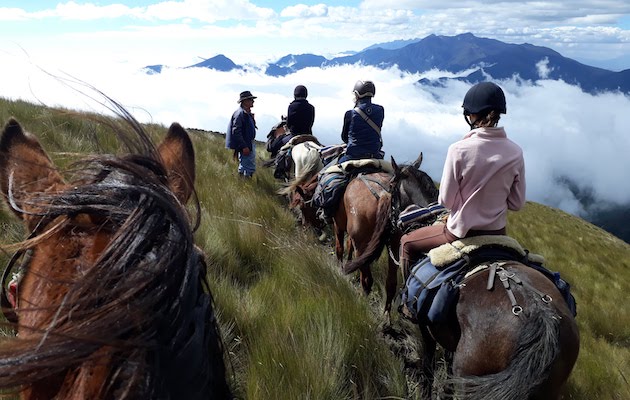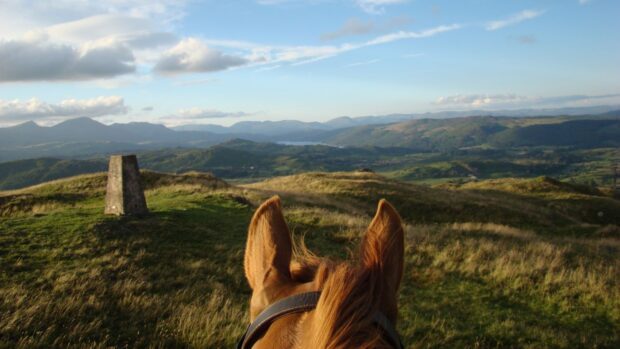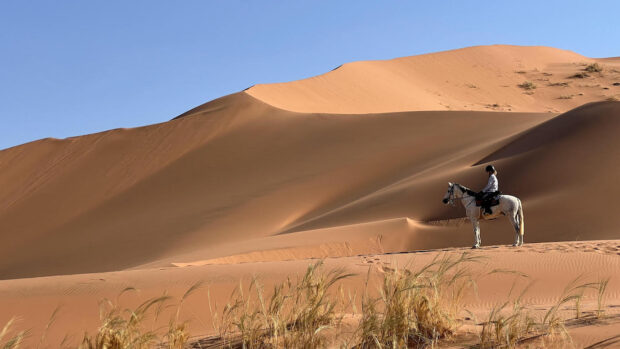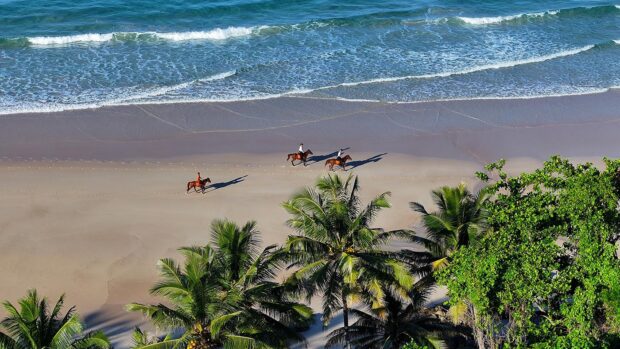Thinking about your next adventure? H&H’s Lucy Elder takes a look at why riding above the clouds in Ecuador is the most magnificent way to see and learn about this beautiful country
1. This is a real adventure across a landscape so huge it is almost impossible to take it all in. One day, I watch a storm in its entirety move across the landscape behind us. Rainbows are no longer something that arch above you, they are below you, behind you — a small part of the vast sky. We ride above the clouds, along paths that cling to the edge of volcanoes (don’t look down…), past herds of wild horses, galloping across plains at 4,000m… the country is magnificent and what better way to see and learn about it than from the back of a horse?

Guido looks across the valley towards the dormant volcano Rumiñahui as we climb into the Andes
2. It’s completely physically exhausting — any desk-bound rider will know just how glorious it is to feel bone-tired after riding, compared to mentally tired from staring at a screen all day. Ecuador is high, you land in Quito at 2,850m (altitude sickness can start from around 2,000m) so can feel the lack of oxygen as soon as you step off the plane. The route then climbs a further 1,370m over the next 12 days. While it is well-planned to gradually acclimatise riders, spending five to 10 hours a day in the saddle with thin air is hard work, but so worth it.

One of the loose horses takes a break while we admire the scenery on the edge of the Quilotoa crater lake
3. The horses — clever, bold, strong and with exceptional temperaments, the horses know and love their job. They are all bred by Gabriel Espinosa, our guide who owns and runs the Hacienda La Alegria riding base in the “avenue of the volcanoes”. He uses a mix of Arab, Argentine polo pony, Criollo, warmblood, Andalusian and thoroughbred, to get a perfect balance of sure-footedness, sanity, endurance, height and blood for trekking. The whole base has a happy, relaxed atmosphere, which is reflected in the horses. We ride in a small herd, with several running loose alongside us, meaning the horses are able to enjoy a break from being ridden along the way.

The horses take a dip in a lake below Cotopaxi’s imposing crater, hidden by cloud
4. The guides — these are true horsemen and they miss nothing. Gabriel’s passion for his horses and his country are infectious. He matches me with a fierce, fiery and grumpy chestnut called Muñeco, who becomes my main ride for the week. The little horse has the strength of 10 tigers and an enormous ego. It’s a standing joke that I love grumpy animals and we get along famously. Watching one of our guides, Guido, vault bareback onto one of the loose horses with just a rope halter for steering and gallop down the mountain after a splinter-group of troublemakers — neatly rounding them up — is hands-down one of the most exceptional displays of horsemanship I’ve ever seen

Guido and Gabriel lead the way across the volcanic landscape as we head past the snow-capped peak of Cotopaxi (right corner)
5. The escape — yes the WiFi is going to be patchy in places, no there won’t be electricity at others. But does it matter? Not a bit. There’s a satellite phone in case of emergencies and there’s generally mobile signal if you absolutely have to check-in with home, but it’s so liberating to be cut-off, if only for a little while. We stay a night in Tambopaxi Lodge, which looks out to Cotopaxi’s snow-capped summit and is a popular acclimatisation base for climbers. The maps of the emergency escape routes are a visible reminder that this really is an active volcano (last eruption was in August 2015).

Views are always improved when seen from between a pair of ears
6. The accommodation — magnificent views, soft sheets and a mix of cosy hostels and more luxurious guest houses (plus one night in a shack). Ride well, rest harder. There are also hot tubs dotted along the way, as well as sunrise yoga one morning to stretch-out those aching muscles. Refuel with soup, steak and red wine.

A bedroom at Hacienda La Cienega — a beautiful guesthouse filled with scientific and social history
Top tips…
✔ Invest in padded pants — don’t skimp on these to save on baggage. Think Bridget Jones meets Laura Kenny
✗ Don’t forget the Dioralyte — high altitude and physical exhaustion are demanding; these sachets are a cheap and effective way to help rehydrate
✔ Brush up on your Spanish — Gabriel’s English is perfect, but many of the horsemen speak only Spanish. Your horse will also speak Spanish
✗ Don’t follow loose horses — follow your guide instead
✔ Get fit before you go, particularly if you don’t ride frequently
✗ Don’t look down…
✔ Be prepared to go with the flow

Escape among the clouds
Prices for the Cotopaxi to Quilotoa volcano trail start from €2,870 (£2,576). For information on this trip and more Ecuador rides, visit equus-journeys.com or call 01905 388977.
Don’t miss this week’s issue of Horse & Hound (3 January) — out now — for the full feature on the ride.





